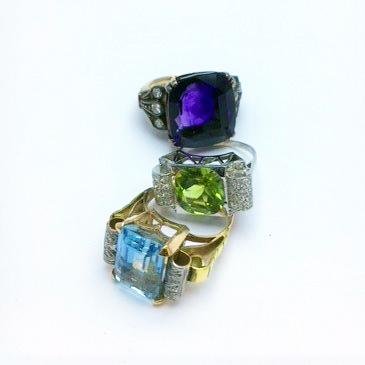Add some colour to your outfit with a piece of jewellery set with one of these stones:
AMETHYST
Amethyst is a violet variety of quartz. Natural amethyst colours range from light pinkish purple to a rich, darker purple. The hardness of the quartz makes it suitable for jewellery.
Amethyst was used as a gemstone by the ancient Egyptians, largely used for intaglio engraved and carved gems – the design being cut into the flat background of the stone.
The Greeks believed that amethyst gems could help prevent intoxication, while soldiers in medieval times wore amulets made of amethyst believing that the stone healed people and kept them cool headed.
Amethyst is a semi–precious stone and is the traditional birthstone for February.

AQUAMARINE
The aquamarine is the birthstone for March. A cool pastel tone of blue that perfectly suits the start of spring. Aquamarine comes in a range of blue shades.
The name Aquamarine comes from the Latin aqua marinus, meaning "water of the sea," and refers to its sparkling ocean-like colour. The pale blue, transparent crystal is a member of the Beryl family. Its colour, is caused by iron oxides within the chemical makeup of the stone.
Aquamarine is an ancient talisman used by the Romans to purify water, and to guarantee safety when travelling by sea. It was carried by sailors as a talisman against drowning.

CITRINE
Citrine is a coloured variety of quartz in a medium deep shade of golden yellow. It has been described at various times as yellow, greenish yellow, brownish yellow or orange. The original reference point for the citrine colour was the citron fruit. The first recorded use of citrine as a colour in England was in 1386. It was borrowed from a medieval Latin and classical Latin word with the same meaning.
In late medieval and early modern English the citrine colour name was applied in a wider variety of contexts than it is today. In today's English citrine as a colour is mostly confined to the contexts of gemstones, including quartz, and some animal and plant names.
PERIDOT
Peridot is one of the few gemstones that occur in only one colour: an olive green. The intensity and tint of the green, depends on the percentage of iron content in the crystal structure, so the colour of individual peridot gems can vary from yellow, to olive, to brownish-green.
Peridot is a type of Olivine, and it is often found in lavas, carried to the surface; but gem quality peridot occurs in only a fraction of these settings. Peridots can also be found in meteorites.
Peridots can be differentiated by size and composition. A peridot formed as a result of volcanic activity tends to contain higher concentrations of lithium, nickel and zinc than those found in meteorites.
Olivine in general is a very abundant mineral, but gem quality peridot is rather rarer. This is due to the mineral's chemical instability on the Earth's surface. Olivine is usually found as small grains, and tends to exist in a heavily weathered state, unsuitable for decorative use. Large crystals of forsterite, the variety most often used to cut peridot gems, are rare; as a result olivine is considered






